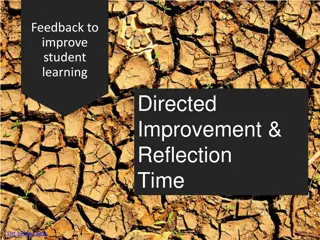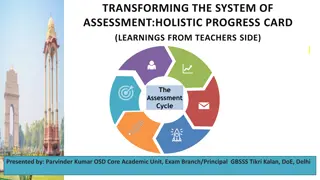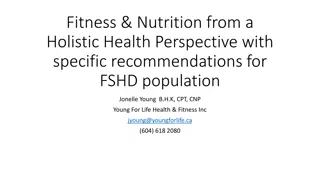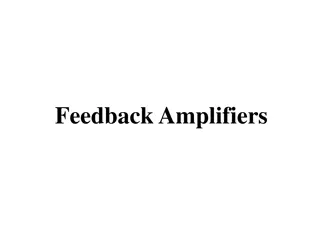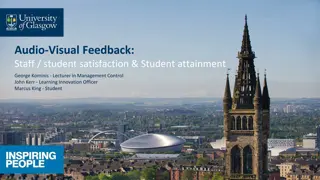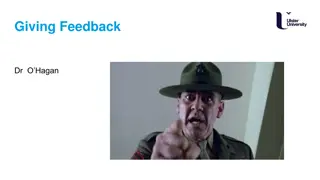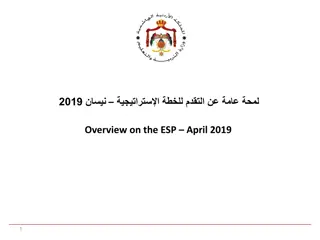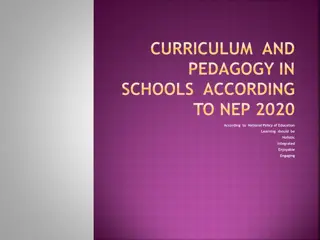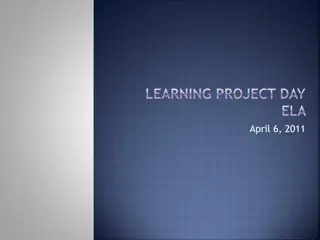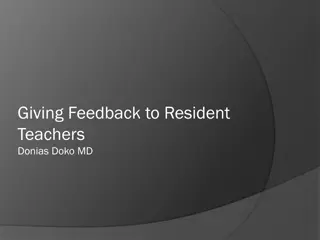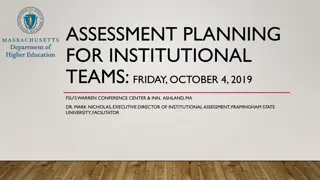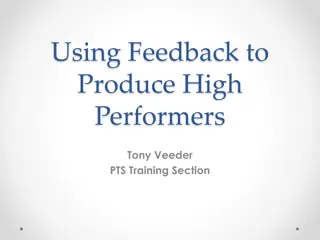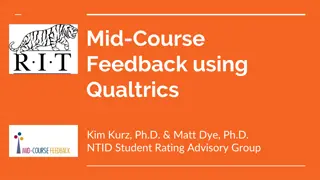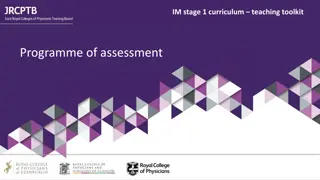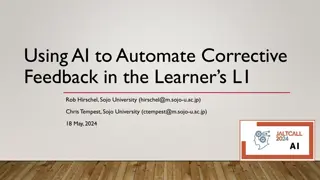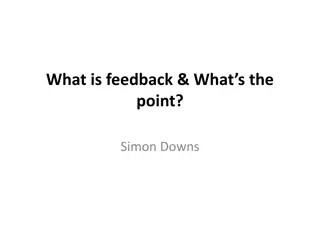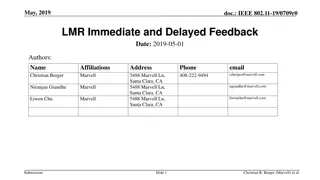Advancing Assessment in Education: Focus on Holistic Progress and Feedback
Embracing a shift in educational assessment, the focus is on promoting student learning and development through regular formative assessments. The NEP mandates emphasize competency-based evaluations, self-assessment, and interactive tools for student progress tracking. Holistic Progress Cards offer a comprehensive view of students' cognitive, affective, and psychomotor domains, enhancing communication between schools, parents, and teachers.
Download Presentation

Please find below an Image/Link to download the presentation.
The content on the website is provided AS IS for your information and personal use only. It may not be sold, licensed, or shared on other websites without obtaining consent from the author.If you encounter any issues during the download, it is possible that the publisher has removed the file from their server.
You are allowed to download the files provided on this website for personal or commercial use, subject to the condition that they are used lawfully. All files are the property of their respective owners.
The content on the website is provided AS IS for your information and personal use only. It may not be sold, licensed, or shared on other websites without obtaining consent from the author.
E N D
Presentation Transcript
NEP Mandate: GOALS Ensuringthat the primary purpose of assessment is to promote the learning and development of students. 1 Focus on regular formative assessment for learning rather than a summative assessment that encourages today s coaching culture' 2 The shift from testing rote memorization skills to competency- based and testing higher-order skills such as analysis, critical thinking, and conceptual clarity. 3 Enabling assessment to help the school system to continuously revisit teaching-learning processes to optimize the learning and development of all students. 4
NEP Mandate: PROCESS Provisions for self-assessment and peer assessment along with teacher assessment. 1 Along with paper-pencil tests, the scope for alternate assessment procedures that record the progress of children in project-based and inquiry-based learning, quizzes, role-plays, group work, portfolios etc. 2 Development of a 360 Development of a 360- -degree holistic multidimensional Progress Card which degree holistic multidimensional Progress Card which would reflect the progress as well as the uniqueness of each learner in the would reflect the progress as well as the uniqueness of each learner in the cognitive, affective, and psychomotor domains; and be an important link between cognitive, affective, and psychomotor domains; and be an important link between parents and teachers. (Para 4.35) parents and teachers. (Para 4.35) 3 Development of interactive software to enable students to track their progress and get information on their strengths, areas of interest and needed areas of focus. 4
Why HPC? Grades do not give a clear picture of student learning. What are the substitutes ? What do parents, teachers and students want to know from a progress card ? What are the various ways in which the school can communicate progress? Performance is never static ,it has to be measured over a period of time.
How does the Progress report provide feedback for the student ,so as to facilitate progress in learning? How does a Parent know the uniqueness in their child? How can the Progress be a log of performance and conversation with Parents and students? Is it possible to help parents see the connections and possibilites of the direction in which the student is growing ? How can the teacher`s burden to fill in progress reports be decreased?
All above questions/premise can be answered by the HPC that will be: 01 A Pedagogical Tool A Process through which both the teachers and the parents will equally participate for the student achievement of competencies 02 A Tool to enable society to participate in a student's development and progress 03
HPC is , thus, a Collaborative endeavor. HPC is , thus, a Collaborative endeavor. Parents Teachers HPC Learner Peers
AIM & SPIRIT OF HPC Be a dynamic and continuous process aiding the growth and the development of the learner instead of assessing or judging the final outcome only The process of learning needs to be given more importance than the product. Assessment As , Provide insights regarding the learner's strengths, areas of interest as well as scope for improvements Of and For learning
Recommended to include multiple forms of assessment tools having varying and flexible formats (e.g. objective to descriptive, visual, or any other format)to assess all aspects of development in their entirety Acknowledge and celebrate the uniqueness of each learner Trace the progress or all-round development of the learner
FEATURES OF HPC Participatory and learner centric approach Inclusive Assess the task and not the learner - Assess the ability of the child to complete an assessment according to defined competencies and skills continuously. Builds on self-awareness and self-esteem: The HPC communicates the strengths and areas of improvement with participation and discussion between the teacher, the child and where possible, the parent.
Goal setting: The HPC includes opportunities for the child in consultation with the teacher to set future goals thus providing direction to both, teacher and the child in terms of future action. Tracks skills and competencies: Assesses the competencies and skills as laid down in NIPUN Inter-disciplinary: The HPC encourages and offers possibility for inter-disciplinary task assessment under which individual tasks can be assessed, in alignment with the recommendations of the NEP 2020 to break the subject silos. Flexible: Activities/ Tasks, Prompts, Templates and formats will be provided to the teacher. And, there will be a possibility to customise them according to a school s individual needs, making the HPC a flexible tool.
Structure Section 1 Developmental Goals and Competencies STRUCTURE OF HPC Section II Section III Portfolio Parents Feedback .
HPC Format HPC Format This is a suggestive exemplar card based on the NIPUN BHARAT Guidelines prepared for classes Pre-school 1 to grade 3. CBSE affiliated schools may adopt / adapt the card as per their requirement, context, locality and priorities. This card is an individualized and comprehensive representation of a student s progress. HPC builds on continuous assessment to present a picture of the student s progress across a specific time. It provides disaggregated reporting, unlike a single score or letter grade in a subject area. A comprehensive list of age/grade-wise outcomes is given in the Foundation Literacy and Numeracy Framework NIPUN which are expected to be covered during classroom sessions. However, for the purpose of reporting the progress of a student, selected competencies that represent the critical areas of instruction and development are highlighted in this Card along with each developmental goal.
These Competencies are year-long expectations and are to be measured with the following scale: LEVEL INTERPRETATION Beginner The student is at the beginning stage of the target competency and needs a great deal of support and handholding. Progressing The student is able to meet some part of target competency independently but needs some (occasional) support and handholding. Proficient The student is able to meet the target competency independently, without any support. These goals are to be met with the use of activity-based and experiential learning pedagogy by the teacher to enable a child to develop competencies. Observation and discussions by a teacher are also integral part of pedagogy required.
When a child is at the beginner level, it would be desirable that a teacher include a narrative how she/he will support the child and what parental support is required. For the purpose of representation of the level in the card, schools must select any non- hierarchical and neutral icon such as a flower, tree, smiley etc. Teachers must keep the record of the baseline level for each student at the beginning of the session. Child s records of the previous class can be the baseline. The Progress Card document is a combination of a child s own expression of self as well as the teacher s assessment of the child on the mentioned standards. There is also a section on Self-Assessment and Peer Assessment, which shall reflect child s self-reflection and peer-reflection on the basis of some tasks of activity- based/ experiential learning.
This gives a complete picture of the child and provides an evidence as well as an opportunity to the child to present her growth in the progress review over years. Finally, a pictorial evidence of the child s work is represented in the portfolio section. This will essentially present the child s work in the task assigned.
THANK YOU! THANK YOU!


